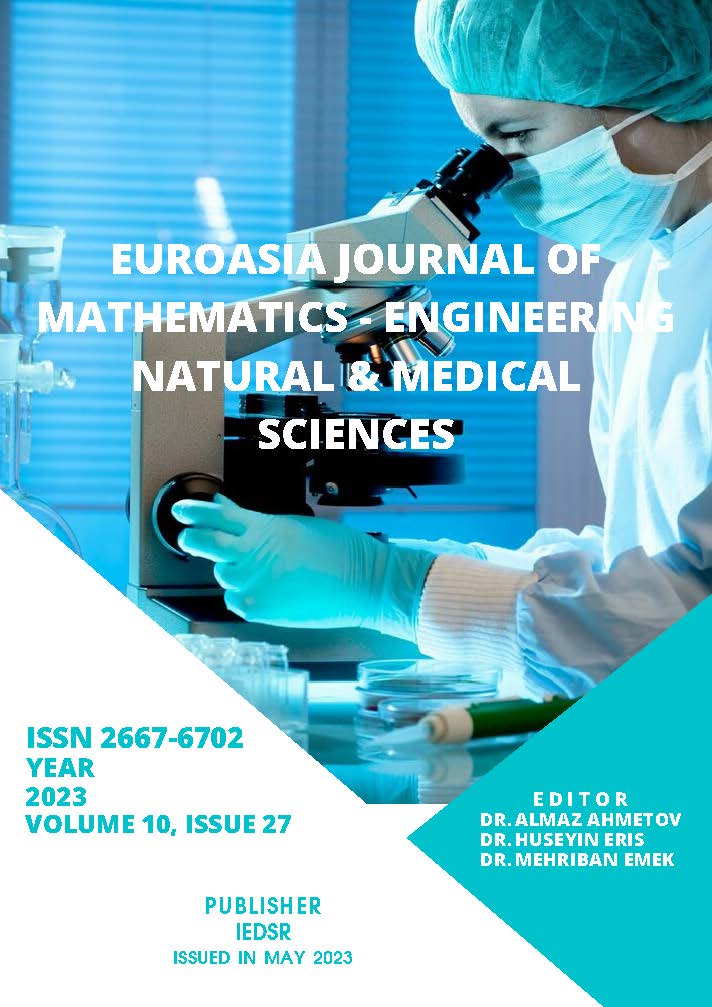Dolichoarteriopathies (Kinking, Looping, Tortuosity) of the Vertebral and Basiler Arteries
DOI:
https://doi.org/10.5281/zenodo.7964616Keywords:
vertebral artery, basilar artery, dolichoarteriopathiesAbstract
The aim of this study is to document dolichoarteriopathies (kinking, looping, tortuosity) of the vertebral artery and basilar artery and to measure the external diametrs of the vertebral artery and basilar arteries with DA using CE-MRA. Subjects were divided into six groups according to with or without DA of the VA and BA seen on the contrast enhancement magnetic resonance angiography (CE-MRA). The external diameters of the vertebral artery (VA)and basilar arteries (BA) with and without dolichoarteriopathies (DA) were measured and compared with each other. The most common DAs of the VA were tortuosity (40.7%), followed by looping (6.5%) and kinking (2.6%). Tortuosity and kinking of the BA were seen 7.6% and 0.5%, respectively. The prevalence of the V1, V2, V3 and V4 segments with DA were seen 22.3 %, 12.5%, 8.7%, and 9.5% respectively. The present study demonstrated the external diameters of the BA and VA with DA were larger than the ones without DA. The most common DAs of the VA were tortuosity, looping and kinking, respectively. The incidences of DA according to the segments of the vertebral arteries were V1, V2, V3 and V4, respectively. The most common DAs of the BA were tortuosity and kinking, respectively. VA and BA with DA have larger external diameter than without DA.
References
Beigelman R, Izaguirre AM, Robles M, Grana DR, Ambrosio G, Milei J.(2010). Are kinking and coiling of carotid artery congenital or acquired? Angiology, 61:107-12.
Buckenham TM, Wright A.,(2004), Ultrasound of extracranial vertebral artery, Br J Radiol, 2004; 77: 15-20.
Caplan LR,Gorelick P.B, Hier DB.(1986). Race, sex, and occlusive cerebrovascular disease: a reviev. Stroke, 17:648-655.
Cosar M, Yaman M, Eser O, Songur A, Ozen OA. (2008). Basilar artery angulation and vertigo due to the hemodynamic effect of dominant vertebral artery, Med Hypotheses , 70:941–943.
Dodevski A, Lazareska M, Tosovska-Lazarova D, Zhivadinovik J, Aliji V.(2011). Morphological characteristics of the first part of the vertebral artery, Prilozi, 32:173–188.
Doweidar A., Al-Sayed S, and Al-Kandery S. (2014). Symptomatic Vertebral Artery Loop: A case report and review of literature, J Radiol , Case Rep 8: 35–41.
Fan BH, Xu L, Lin M, Li W, Wang FJ, Xu QZ. (2015). Pathomorphological change of the atlanto-occipital segment of vertebral artery related with cervical vertigo]. Zhongguo Gu Shang, 28:39-42.
Han HC.(2012). Twisted Blood Vessels: Symptoms, Etiology and Biomechanical Mechanisms, J Vasc Res,49: 185–197.
Hassler O. (1967). Arterial deformities in senile brains. The occurrence of the deformities in a large autopsy series and some aspects of their functional significance, Acta Neuropathol ,8:219–229.
Hong-tao Z, Shu-ling Z, Dao-pei Z (2014) .Two case reports of bilateral vertebral artery tortuosity and spiral twisting in vascular vertigo, BMC Neurol ,14: 14.
Jeng JS,Yip JK.(2004). Evaluation of vertebral artery hypoplasia and asymmetry bby color-coded duplex ultrasonography, Ultrasound Med Biol.,30.605-609.
Jeong SK, Lee JH, Nam DH, Kim JT, Ha YS, Oh SY, Park SH, Lee SH, Hur N, Kwak HS, Chung GH. J. (2015). Basilar artery angulation in association with aging and pontine lacunar infarction: a multicenter observational study, Atheroscler Thromb 22:509-17.
Kim HS, Lee JH, Cheh G, Lee SH.(2010). Cervical Radiculopathy Caused by Vertebral Artery Loop Formation : A Case Report and Review of the Literature., J Korean Neurosurg.,48:465–468.
Lee SH, Hur N, Jeong SK. (2012). Geometric analysis and blood flow simulation of basilar artery, J Atheroscler Thromb,19: 397-401.
Matskevichus Z K, Pauliukas P A.(1990). Morphologic changes of the arterial wall at the site of the loops and kinks of the carotid and vertebral arteries. Arch Patol ( Moscow ), 52: 53-58.
Matula C, Tratting S, Tschabitscher M, Day JD, Koos WT.(1997). The course of the prevertebral segment of the vertebral artery: anatomy and clinical significance, Surg Neurol ,48: 125-131.
Oliviero U, Scherillo G, Casaburi C, Di Martino M, Di Gianni A, Serpico R, Fazio S, Sacca L. (2003). Prospective evaluation of hypertensive patients with carotid kinking and coiling: an ultrasonographic 7-year study, Angiology ,54:169–175.
Paksoy Y, Levendoglu FD, Ogün CO, Ustün ME, Ogün TC. (1976). Vertebral artery loop formation : a frequent cause of cervicobrachial pain., Spine (Phila Pa) ,28:1183–1188.
Pancera P, Ribul M, Presciuttini B, Lechi A(2000). Prevalence of carotid artery kinking in 590 consecutive subjects evaluated by echo-color Doppler. Is there a correlation with arterial hypertension? J Intern Med ,248:7–12.
Pauliukas PA, Streĭkis LK, Riapiachka AA.(1990). Diagnosis and surgical treatment of anomalies of the vertebral arteries], Khirurgiia (Mosk),Nov:10-15.
Rusu MC. Ascending vermian artery, branch of the V4 segment of the vertebral artery. Surg Radiol Anat. 2011; 33:727-9.
Savitz SI, Caplan LR.(2005). Vertebrobasilar disease, N Engl J Med ,352:2618–2626.
Schep G, Kaandorp DW, Bender MH, Weerdenburg H, van Engeland S, Wijn PF. (2001).Magnetic resonance angiography used to detect kinking in the iliac arteries in endurance athletes with claudication, Physiol Meas ,22:475–487.
Stehbens W E, Fee C J.(1985). Hydrodinamic flow in U-shaped and coiled glass loops simulating carotid arterial configurations, Angiology,36: 442-451.
Togay-Isikay C, Kim J, Betterman K, Andrews C, Meads D, Tesh P, Tegeler C, Oztuna D. (2005). Carotid artery tortuosity, kinking, coiling: stroke risk factor, marker, or curiosity? Acta Neurol Belg, 105:68–72.
Trucco E, Azegrouz H, Dhillon B.( 2010). Modeling the tortuosity of retinal vessels: does caliber play a role? Ieee Trans Biomed Eng, 57:2239–2247.
Ulusoy OL, Sasani H, Barlas SB, Mutlu A, Sasani M.A. (2016). Case of Anomalous Origin and Course of Vertebral Artery in a Patient with Klippel Feil Syndrome, Korean J Radiol ,17: 554–557.
Veeramani R , Shankar N. (2014). Anatomical variations of the pre-transverse segment of the vertebral artery in Indian cadavers, Eur. J. Anat ,18: 159-163.
Weibel J, Fields WS. (1965).Tortuosity, coiling, and kinking of the internal carotid artery. II. Relationship of morphological variation to cerebrovascular insufficiency, Neurology,15: 462–8.
Downloads
Published
How to Cite
Issue
Section
License
Copyright (c) 2023 Euroasia Journal of Mathematics, Engineering, Natural & Medical Sciences

This work is licensed under a Creative Commons Attribution-NonCommercial 4.0 International License.

